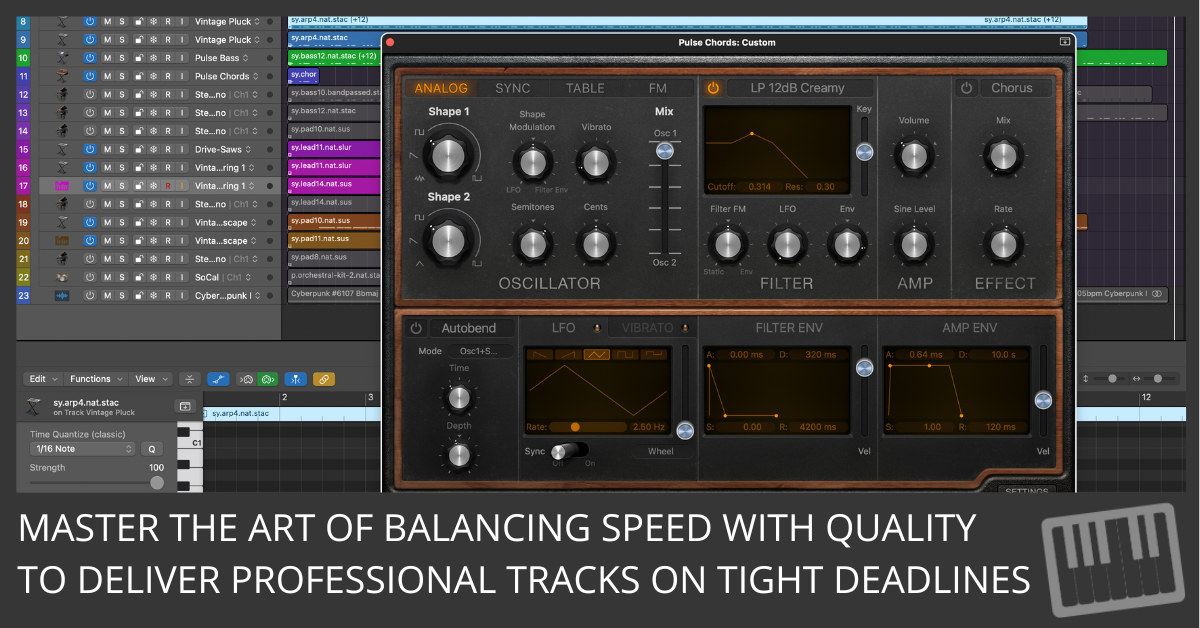
How do the best producers crank out top-quality tracks on tight deadlines?
Top producers know that balancing both isn’t about cutting corners but working smarter with razor-sharp strategies.
Here are four ways seasoned producers keep quality high, even when time is tight.
1. Plan and Batch Track Components to Maximize Flow
Producing music quickly without losing quality begins with effective planning. Here’s how to set yourself up for success from the very start.
- Map Out Your Track: Outline what’s needed in the track — drums, bass, keys, vocals, effects. List each layer or component you want, and assign roles if you’re working with a team.
- Batch Recording for Efficiency: Instead of recording each instrument one by one, record in layers. For example, lay down all drum tracks in one go, followed by the bass, then the keys. This lets you stay in a focused flow for each component, which speeds up the process without sacrificing sound quality.
- Plan Effect Settings and Presets: Pre-select settings for effects, EQs, and reverbs for each instrument to avoid time-consuming adjustments later on. Consider saving presets tailored to your genre or track style.
For example: If you’re recording drums, select a preset that highlights punch and clarity for the kick and snare, so when it’s time to mix, you’ve already shaped these core sounds.
2. Use Reference Tracks to Stay on Target
A well-chosen reference track can serve as a quality benchmark, helping you stay focused and make faster decisions. This trick isn’t just for mixing — it’s about keeping the entire production on course.
- Pick a Track with the Right Vibe and Quality: Look for a song in a similar genre and tempo that represents the sound you’re aiming for. Import it directly into your DAW session for easy access.
- Check Your Progress Regularly: Pause every 15-20 minutes to compare your track against the reference. Focus on individual elements like the bass, drums, and vocals. Is your bass hitting as hard? Is the vocal clear enough? Make adjustments as you go.
- Use Reference Tracks to Guide Sound Choices: If the reference track has an upfront vocal, emphasize that in your mix by using similar EQ and reverb choices.
To get started: Import the track, set a regular check-in timer, and use these comparisons to keep your production elements in line with industry standards.
3. Set Trim Levels Early and Stick to Them
Quality starts with getting the basics right, and one foundational step is setting solid trim levels. Many new producers waste hours trying to fix distorted sounds, but experienced producers know better. They start with disciplined levels, creating a clean base to work from.
- Set Specific Trim Levels for Instruments: Keep loud instruments like vocals and kick drums between -12 and -18 dB. To maintain clarity in your mix, avoid clipping at all costs.
- Use a Consistent Loudness Reference: For the loudest instruments, your meters should not exceed -6 dB. This range ensures your track has room to breathe, which pays off in the mixing and mastering stages.
Here’s what to do next: Set your trim levels, then lock them. Avoid touching them unless absolutely necessary to maintain consistent quality.
4. Nail Your Workflow with Templates and Presets
Top producers don’t reinvent the wheel every session; they lean on templates and presets to get quality results fast. This isn’t a shortcut—it’s a smart way to keep your sound consistent while saving time on repetitive tasks.
- Use Templates for Different Project Types: For example, create a template for hip-hop projects with drum, bass, and vocal tracks preset. Another for orchestral pieces with string, brass, and woodwind tracks in place. Add reverb, EQ, and compression settings that suit each type.
- Organize Your Presets for Fast Access: Sort them by instrument, effect, or even mood. If you know you’re working on a soulful track, having reverb and delay presets that emphasize warmth can instantly dial in the right vibe.
- Keep Effects Minimal but Intentional: Overusing effects can muddy your track and slow you down. Instead, choose a few high-quality plugins and use them sparingly to get a polished sound without the clutter.
For example: When producing a pop track, you might use a template with a compressor already set on your vocal bus, which keeps levels consistent throughout the session.
Mastering quality on a tight timeline takes more than just skill; it’s about creating a workflow that’s both fast and precise. With these four techniques, you can speed up production while keeping your sound top-notch. Start using these strategies today, and you’ll see how quickly they pay off, both in time saved and quality delivered.
Enter your first name and email address and click the "Get Access Now!" button to get your free mixing guide.
Your Information is 100% Secure And Will Never Be Shared With Anyone!
